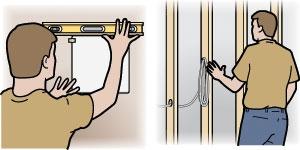Step By Step: How to Install an In-Wall Speaker

Until recently, in-wall speakers were the last choice for anyone who cared about sound quality. Now, thanks to improved technologies and the entrance of major speaker brands into the burgeoning "architectural audio" category, in-wall (and ceiling) speakers are legitimate alternatives in rooms where you either can't or don't want to use freestanding models.
Installing an in-wall speaker is well within the ability of most weekend warriors, particularly in new construction where the wall studs are exposed. You might want to use a professional installer if your setup is complicated, such as a whole-house audio system, a home theater with in-wall subwoofers, or an old house with plaster walls. Otherwise, here are the steps to consider:
Step 1: Choose the Location As with any construction project, proper planning can save you a lot of grief. First, determine where your gear will be and plot the easiest route from there to the speakers. Consider where you'll be doing most of your listening, and place the speakers for the best sound for that area. It's easy to run wire during new construction while the studs and joists are exposed. In existing rooms, you'll want to run wires through the attic or the basement, if possible, to minimize obstructions. (Also consider running them behind baseboard molding.)
Step 2: Run the Wires In new construction, speaker cables are usually run after the high-voltage wires (so you can avoid them) and just before the drywall goes up. In-wall speakers require CL-2 or CL-3 wires approved for in-wall use. Don't use any other type of wire. If you're doing new construction, the electrical inspector will check these wires - and if you have a fire and it's discovered that you used the wrong wiring, your insurance company might deny your claim. Use 18-gauge or thicker wire for runs under 50 feet, 16-gauge or thicker for 50- to 100-foot runs, and 12-gauge wire for anything longer than that.
Place the speaker wires at least a foot from any parallel power-line runs to avoid electrical interference. If speaker wires need to intersect AC wires, cross them at 90° angles. And if you have to go through studs or joists, drill the holes in the center of the wood. (Fish tape can help you thread wires through existing walls.) Avoid studs with electrical outlets attached to them.
Once you're near the speaker location, leave a 4- to 5-foot coil of wire attached to the nearest stud. This will give you plenty of play, and you can cut the wire once you're sure you want to put the speaker there. You can also make a cardboard template of the speaker and frame it between two studs. Then, whoever's putting up your walls can cut a small hole in the drywall there and pull the speaker wire through. Some speakers come with rough-in brackets, which serve a similar function. Also, if you think you might expand your speaker setup at a later date, run the wires now. Wire is cheap; labor isn't.
- Log in or register to post comments






























































